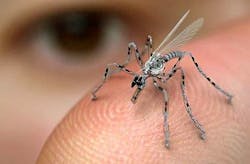DARPA chooses two to develop insect-size robots for complex jobs like disaster relief and hazardous inspection
Officials of the U.S. Defense Advanced Research Projects Agency (DARPA) in Arlington, Va., have awarded two contracts over the past two weeks for the SHort-Range Independent Microrobotic Platforms (SHRIMP) project.
SHRIMP, sponsored by the DARPA Microsystems Technology Office, is developing new actuators, multi-mode power for future untethered insect-scale robots -- also called micro-to-milli robotic platforms.
DARPA on Monday awarded a potential $3.6 million contract to Honeywell International Inc. Automation and Control Solutions (ACS) division in Golden Valley, Minn.; and a potential $1.3 million contract on 25 Feb. 2019 to Rutgers University in New Brunswick, N.J., for separate technology thrusts of the SHRIMP program.
Key drivers are mobility, manipulation, actuator material, power storage and endurance, conversion circuitry, and engineering for extremely small size, weight, and power (SWaP).
Insect-scale robotic research has benefited from prior technological advances in microelectromechanical systems (MEMS), additive manufacturing, piezoelectric actuators, and low-power sensors, DARPA officials explain.
As yet, there are there are no complete micro- or milli-robotic systems able to perform complex jobs proficiently. Today, most micro- and milli-robots today rely on physical, optical, magnetic, or RF tethers to supply power, control, and processing which limits their utility.
Researchers at Honeywell and Rutgers will focus on developing fundamental actuator and power components for insect-scale robots, and will demonstrate them at a first responder robotics test facility at the U.S. National Institute of Standards and Technology (NIST).
Actuator technologies for insect-scale-robotics must focus on force generation, efficiency, strength-to-weight ratio, and maximum work density.
Related: Army looks to ReconRobotics for military micro robots for infantry situational awareness
Power storage and conversion will center on enabling insect-scale-robots to perform complex operations without power, control, or processing supplied by a tether.
Actuators will focus on building mechanical moving parts for robot maneuverability, dexterity, and manipulation. Insect scale robotics until now has focused simply on moving, and such robots tend to be simple, possess limited intelligence, and lack the power, navigation, actuation, and control to accomplish tasks beyond this.
DARPA's contracts to Honeywell and Rutgers have base phases and options for second and third phases.
For more information contact Honeywell Automation and Control online at www.honeywellprocess.com, Rutgers University at http://arc.cs.rutgers.edu, or DARPA at www.darpa.mil.
Ready to make a purchase? Search the Military & Aerospace Electronics Buyer's Guide for companies, new products, press releases, and videos
